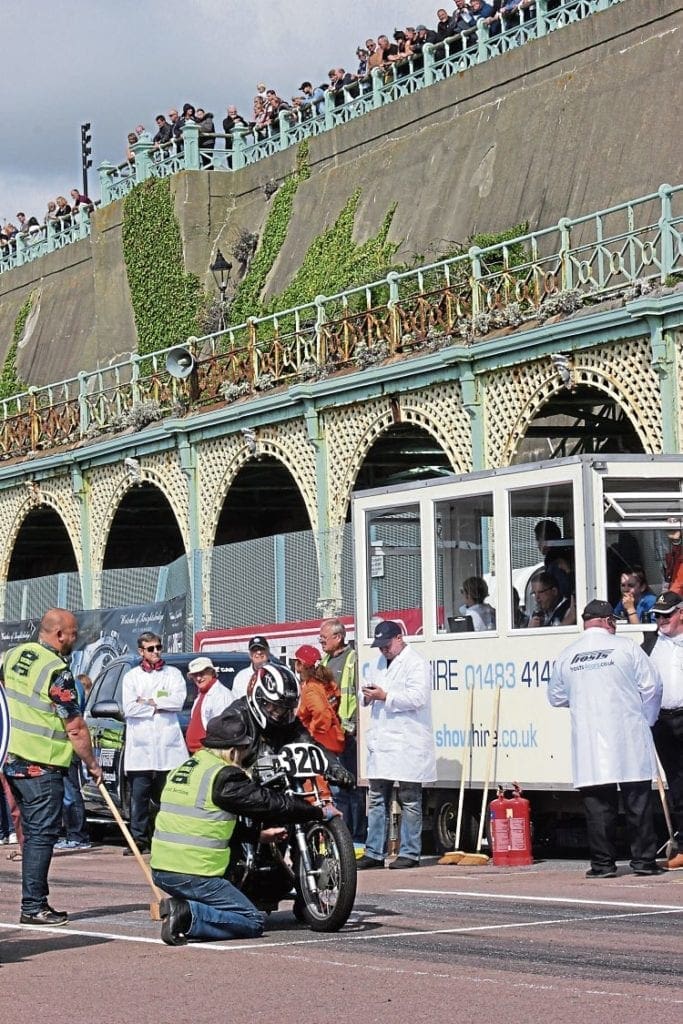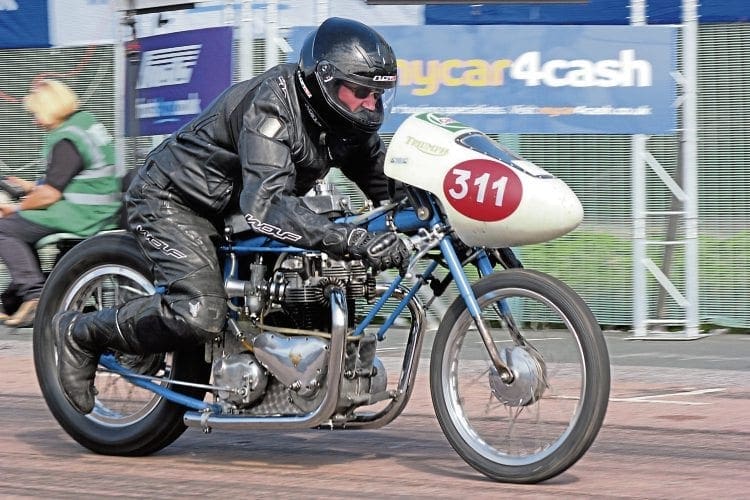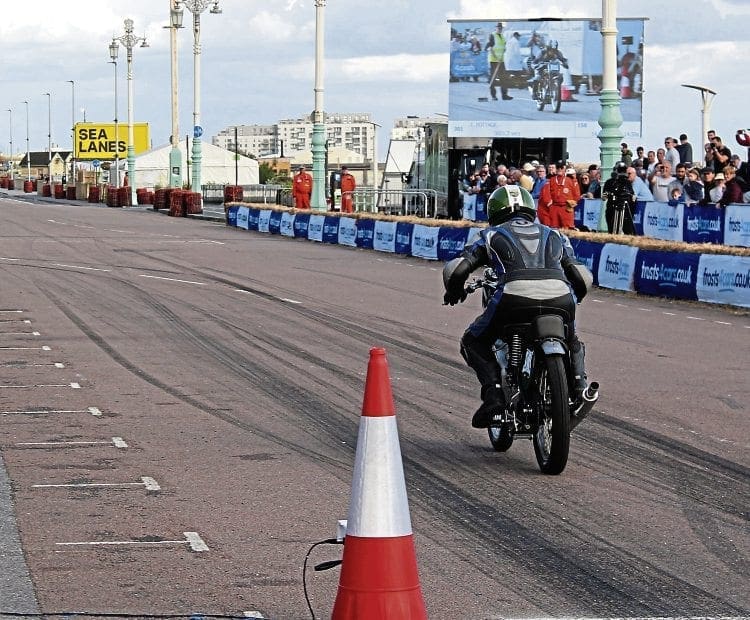There can be few cities nowadays where it is possible to take part in a speed event less than a mile from the city centre. Add in the backdrop of the English Channel and it is all part of the unique appeal of the Brighton National Speed Trials. Instituted in 1905 to show the potential offered by the internal combustion engine, Alan Turner discovers that the Trials continue to serve the self-same purpose, 114 years later.
By invitation of the organising Brighton & Hove Motor Club, the motorcycle side of the event has been looked after by the Vintage MCC (Sprint Section) for many a year.
Various classes are separated by capacity for, mainly, more recent bikes, but Class I holds much of the interest for older machinery.
Open to solo bikes up to 1972, irrespective of engine size, to make a fair competition it is determined by consistency, the narrowest margin between the afternoon’s two timed runs decides the winner.
It is also something of a cavalcade of motorcycle history with the oldest entry being a 1926 Bayley-Cole Douglas that was prepared for competition at Brooklands, and which has an amazing history of success in numerous events in the hands of many different riders over the years.

At present, it is entrusted to Chris Illman. Nearly as old, the 1930 Rudge belonging to the Morgan family has a long association with the Brighton Speed Trials and this year it was Richard Morgan upholding family honours.
Late morning saw everyone called for their first, and only, practice run. Lack of track time adds to the Brighton challenge.
In light of this one performance, the decision has to be made to alter riding technique on the less than grippy start area, or bike set-up, or both.
Easier for the 125cc machines in Class I, posting times in the mid-twenties, but at the other end of the scale, Roy Robertson on his immaculate 1272cc Egli-Vincent was completing the course in half that time.
The afternoon saw the first official timed runs. By now, the start line enclosures were crammed with spectators, with yet more on Marine Parade, the seafront road high above offering a view down on the course.
Sadly, the original viewing terrace (‘The Shelf’, in Brighton parlance) that added much to the Brighton atmosphere, still awaits restoration and remains inaccessible.

Roy Robertson was easily the quickest, thundering off to Black Rock with a 12.25/113mph effort. Clive Hurst’s Kawasaki H1, a 500 triple, was next quickest, the raucous echo fading away until the timing display soon lit up with the 13.95/96mph result.
Several riders were in the 14-second zone. Bikes were dispatched in rapid succession, with a glorious variety of exhaust notes. However, it was all down to the second runs and the arithmetic to decide where the premier award for the class, the John Rich Memorial Trophy, was headed.
It was late in the afternoon before the bikes were called again to the start line. There had been little alteration in weather conditions that might affect times.
Clive Hurst improved on his first run time, but that gave him a 0.28 second difference to put him out of the reckoning as that was just sixth best, the same as John Bottomley with his special 390cc Velocette MAC/MOV mix, running in the 17-second, 60+mph zone.
Gavin Shaw was a hundredth closer, as MadneZ showed it was as quick as it looked. A 14.52 best time and an 88mph fastest terminal speed were impressive numbers, as the bike is powered by an MZ 250 single.
Bob Anderson on his Hagon-JAP V-twin replica, recorded exactly a quarter-second difference for his brace of 14-second runs, matched by Victor ‘Max’ Aldous, reeling off 16-second times on a 200cc Lambretta scooter on which he has sprinted for some years to great effect.

Closer, at 0.23 seconds difference, was Amanda Taylor, riding a Hagon BSA. Once a grass-track bike, it is powered by an early C15 engine taking it to 17-second runs and speeds in the mid-70s.
However, Steve Atkins was surprised to be told he was class winner at this year’s Trials. His mount was a 403cc Greeves Griffon. His runs, 15.60/82mph and 15.44/82mph were just 0.16 seconds apart.
No result for Roy Robertson, as ignition problems for the Vincent stopped him taking his second run. A lack of sparks also accounting for Pete Allum’s very original Hagon-Triumph sprinter and a dying magneto seemed to be the cause of a worsening misfire on the Bayley-Cole Douglas.
Sprinting is all about individual efforts and its history is peppered with examples of sprinters sometimes taking the most unpromising of prospects, improving and often succeeding.
The 350 Class at Brighton saw Gordon Hockings on a stripped-to-the-bone sprint bike with a 1980 Honda CB250RS engine, although he was not able to match the performance of Tony Hudson’s classic Honda-4 RC163 replica. They were a way short of Andrew Embling, on his modern KTM, who reigned supreme.

Richard Wheeldon’s Vincent Grey Flash replica was not the quickest bike in Class III for 500cc bikes, but helped add variety. With more Kawasaki triples chasing honours, Allan Wilkinson’s Jawa-Norton and Stephen Mayes’ Godden both showed speedway engines could still be competitive.
There were few older bikes in the bigger classes. Andy Forward was still getting to grips with his recently completed Triumph Morado supercharged 750 and declined a second run with carburation still requiring finalising.
Tim Boutle’s Honda CX650 turbo was eye-catching, enclosed in a ‘dustbin’ fairing. Christopher Payne’s Honda CBX 1000 appeared in the Production class, perhaps sobering to think this example of Honda’s one-time flagship is now 40 years old!
There was an interesting reunion at Brighton as Roy Francis met Patrick Ward, entered in Class I, riding a 1961 CB92 Chis-Honda 125. This had been converted into a racer by Maidstone dealers Chisholms and had been raced by Roy Francis and another Chisholm employee – Bill Ivy.
Roy had lost track of the bike a while ago, so it was good to see it in action once more, and especially poignant as 2019 marks 50 years since Bill was lost to a racing accident.
Meanwhile, at the sharp end, most of the quickest bikes were in Class VII, Up to 2000cc. Practice had already seen times in the nine-second zone with Craig Mallabone clocked at 164mph as he crossed the finish line.
It was a similar story with the timed runs as Craig’s winning time was 9.04/168mph. The six fastest bikes get a further run and this saw Dave Holland match Craig’s time. Weapon of choice is a turbo Suzuki Hayabusa.
Vincents in one way or another have long been part of Brighton’s history and there was an interesting display of Stevenage-ware in the paddock. It was a tribute to long-time Brighton Paddock Marshal and Comet enthusiast Bruce Floodthain.
Among them, Brian Chapman had brought ‘Mighty Mouse’, his giant-killing 500cc bike, and ‘Super Mouse’ the V-twin that was his next venture. ‘Methamon’ took Maurice Brierly to sidecar fame while ‘Epimetheus’ was John Renwick’s take on a sidecar Vincent.
The keenness of the competitors and the enthusiastic and knowledgeable Brighton crowd rather proved that the internal combustion engine still has a lot going for it.
View more images and read more News and Features in the January 2020 issue of Old Bike Mart – on sale now!
Caption





